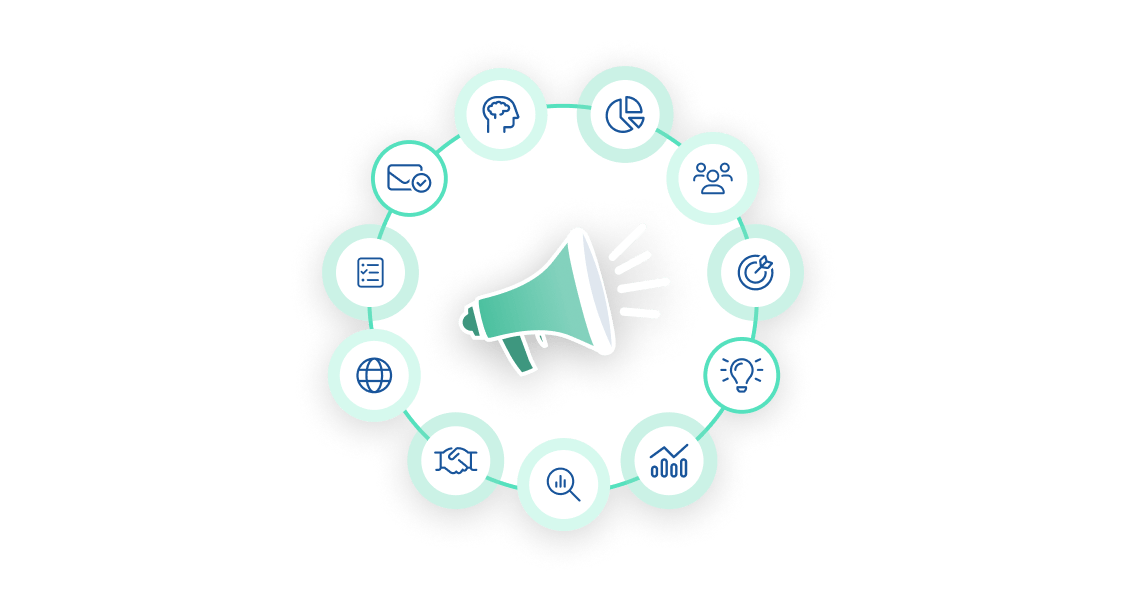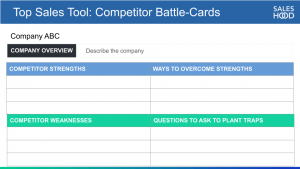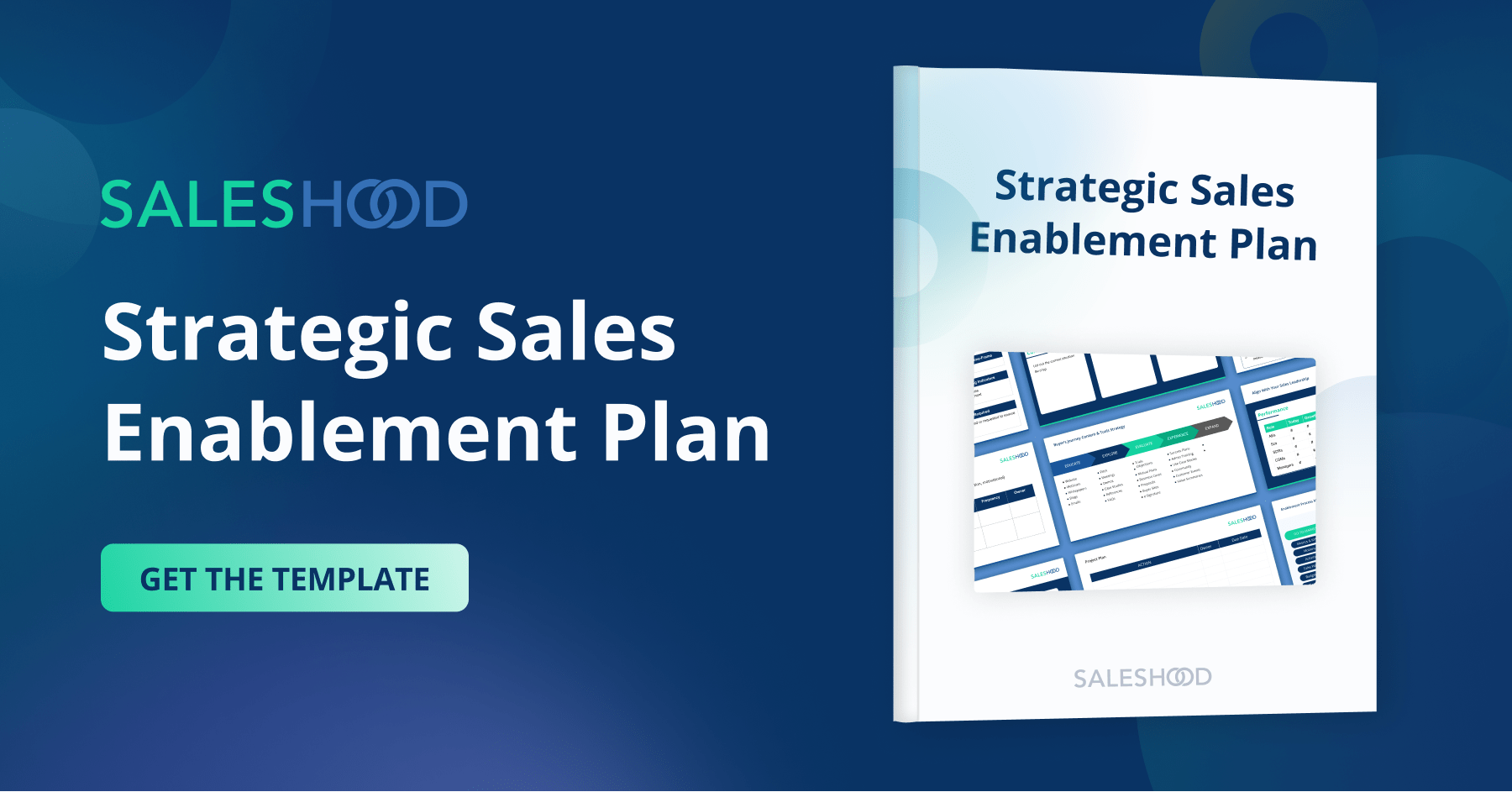We get asked all the time by sales and marketing leaders for help guiding marketing how to embrace sales enablement. SalesHood CEO Elay Cohen recently answered this question in a keynote. Elay explains why it’s important for product marketers to own parts of sales enablement and how product marketers can embrace sales enablement as a growth lever to be better marketers. Below is a recap.
The Product Marketing Playbook for Sales Enablement
Product marketers have a broad set of responsibilities ranging from product positioning and messaging to customer research, product launches, go-to-market strategies, and more. Aiming to drive demand and usage of a product, product marketers must spin a lot of plates. We want to talk about one critical but often overlooked pillar of product marketing: sales enablement. There are thousands of sales enablement professionals worldwide. But this wasn’t always the case. Sales enablement, as a standalone function, wasn’t really a thing until 2005. Before 2005, sales enablement was owned by product marketers. I’m a product marketer at heart, with more than 20 years of product marketing experience, and I’m very passionate about the relationship between product marketing and sales enablement. I believe that it’s very important for product marketers to own key parts of sales enablement. So, we created the must-have Product Marketing Playbook for Sales Enablement.
What Does Great Sales Enablement Look Like?
Great sales enablement doesn’t happen by accident. We want to acknowledge that many of you in product marketing or marketing leadership positions may not really know what great sales enablement should look like. So, let’s start with a quick, high-level look at sales enablement. It’s intentional. It’s purpose-driven. It’s impactful. And it follows a process. Here’s a peek at how we approach sales enablement at SalesHood and how many of our customers are activating their teams with content to learn together, sell smarter and grow faster.
- Publish You’ve got to publish your content, publish your programs, publish your plays, etc. Most people accomplish this, which is excellent. The problem is that most people stop here. But publishing alone isn’t enough. To really lean into and embrace sales enablement, you’ve got to keep going.
- Teach Next, think about how you’re teaching your teams. How do you teach them effectively? At SalesHood, our teams learn by doing. It falls on you to set this up, as teaching and learning opportunities won’t always happen naturally.
- Practice That brings us to practice. Your teams need to practice the pitch and practice the demo until they can show you, not tell you, that they know the programs and know the content.
- Assess Then, you’ll want to assess them formally. This may include having your teams complete assessments to get certified. At the end of the day, what matters is that they can stand and deliver the presentations.
- Apply Then you’ll want to see how they apply the great content you’ve created in real time. You should see your team members applying what they’ve learned to their conversations and deals.
- Coach Next, you’ll want to provide reinforcement. Team managers should provide coaching to help each team member get more comfortable presenting the content and programs you’ve created.
- Sell To help your sales team with the selling process, you’ll need to provide just-in-time materials. This means putting the most relevant content and tools in your sellers’ hands right when they need them.
- Close Next, you’ll want to measure the outcomes and start correlating all the great activities you’ve completed throughout this sales enablement process. This allows you to understand, from a win-loss perspective, what’s working and what’s not working.
- Correlate You should continue to iterate this process. Build, refine and improve your sales enablement process over and over—until you’re completely satisfied.
- Celebrate Finally, it’s a great idea to celebrate successes like completions, certifications, meetings scheduled, new pipeline and deal wins. Capture these wins as videos and create a dynamic library of success stories. These video success stories will be gold especially for new hires.
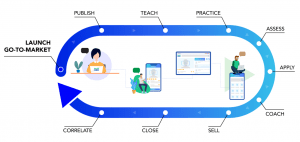 No matter what you’re rolling out, whether it’s a new product, new campaign, new pitch, etc.—when you think about your go-to-market strategy, keep this sales enablement process top of mind.
No matter what you’re rolling out, whether it’s a new product, new campaign, new pitch, etc.—when you think about your go-to-market strategy, keep this sales enablement process top of mind.
Product Marketing Skills & Competencies To Master Sales Enablement
How Product Marketing Will Master Sales Enablement? There are five areas that every product marketer should master to be as great at sales enablement as they are at product marketing:
- Have a collaborative and empathetic mindset
- Be curious and study your sales processes
- Use a proven checklist and templates to roll out sales plays
- Get and keep everyone aligned and on message
- Measure the metrics that matter most
#1: Have a Collaborative and Empathetic Mindset
As product marketers, we want to have the right mindset. I come from a sales background. My father taught me how to sell from a very young age. So, throughout my career as a product manager, I was always very sales-focused. However, this sales-oriented mindset doesn’t come naturally to every marketer. Here are tips to help you develop a collaborative and emphatic mindset:
- Talk (and listen) to sales You’ve got to lean in, which means talking to salespeople and actively listening to what they’ve got to say. Conversations like this will enable you to understand what’s working and what’s not working for sales.
- Sit on customer calls Listening to customer calls is another excellent tactic. By sitting in on these calls, product marketers gain a new perspective.
- Join sales manager meetings Don’t be afraid to join frontline manager meetings. And when you’re there, be an active participant. Raise your hand, take notes, and share your thoughts. You’ll learn a lot simply by talking to the sales managers at your organization.
- Crowdsource sales tools Individuals on your sales team most likely have great tools and content that you’re not aware of. So, get in there and see what they’re using. You’ll find valuable pieces of content that you can clean up and roll out to the masses.
- Be a friend to sales Embrace sales. It sounds simple, and it is. Way back in the day, someone called me a “true friend to sales,” which stuck with me. I want the salespeople at your organization to see you as a true friend that is enabling them to succeed.
#2: Be Curious and Study Your Sales Processes
The second pillar of the Product Marketing Playbook for Sales Enablement is that you’ve got to become a curious student of the sales process. Ideally, you would go through all the training, coaching, and onboarding that your sales team goes through so that you can understand the details of your organization’s sales and customer success processes. For example, a standard sales process will look something like this:
- Prospecting
- Diagnosing
- Prescribing
- Gaining commitment
Now, how do you become a student? I’ll break down what you can do, as a product marketer or marketing leader, to become more curious about your sales process.
- Prospecting
- Read emails
- Check leads
- View pipeline data
- Diagnosing
- Listen to calls
- Look at CRM
- Do sales training
- Prescribing
- Watch demos
- Read proposals
- Talk to customers
- Gaining commitment
- Assess win/loss
- Interview reps
- Share successes
By following these steps, you can train yourself to become super curious about the sales process. Which, in turn, will make you a better product marketer and allow you to better enable your salespeople.
3. Use Proven Checklists and Templates To Roll Out Sales Plays
I get asked all the time, “What should we include when we roll out something new?” There are ten must-have items when you’re launching something new, whether it’s a new product, program, play, or pitch. This ten-item checklist that I’m about to share is also in SalesHood. It’s baked into our platform, and our customers use it to roll out new programs every day—so I know it works.
- Buyer personas
- Micro-pitches
- Prospecting emails & cadences
- Discovery questions
- Meeting guides
- Customer stories
- Value calculator
- Proposal templates
- Competitive battle cards
- Objections
These ten items should be included every single time you’re rolling something out. It’s up to you and your team to ensure this checklist is complete. I can promise you that if you follow this checklist and maintain the collaborative and empathetic mindset we discussed earlier, people will love the work that you deliver. You’ll be able to produce high-value content that helps close more deals. Now, let’s dive into three items on the checklist in greater detail. Again, you can find the entire checklist inside our SalesHood platform, ready to be used. Buyer personas When you’re thinking about your buyers, you want to provide detail. This detail can be delivered in a slide, a doc, a video, testimonials, etc. Feel free to use whichever form works best for your specific needs, as long as you capture the key points. Click to download template. A good Ideal Customer Profile (or buyer personas) will include:
- demographics
- psychographics
- why they buy
- current situation
- compelling events
- metrics and KPIs
- company size
- geography
- industry
This list provides a framework for the most important item on the checklist: buyer personas. And, since most product marketers don’t put enough focus on delivering this level of detail, it’s a great framework to have. If you consistently build out your buyer personas like this, you’ll see results right away. Customer Stories Next, I’m going to dive into a framework for High Impact Customer Reference Stories Many companies do a decent job of creating one or two-minute videos for their website that tell customer stories. Or, they’ll provide a case study that tells the story. But that’s not enough. You also need to equip your sellers with a version of the story that they can tell in two minutes or less. Here’s the framework that we use to teach our sellers how to tell and retell our success stories:
- Lead with impact Encourage your sellers to lead with impact. Don’t start with negativity and business pains. Instead, start with the headline, “Company Y was able to boost productivity 100X” or “In under six months, Company Z was able to generate 10s of millions of dollars.” Get the buyers excited right off the bat.
- Give the context Coach your sellers to follow the headline with context. They should provide details on the situation to help paint the picture.
- Share the journey After providing context, it’s time to share the journey. Have your sales and customer-facing teams outline the steps that were taken.
- Quantify the benefits Instruct your team to punctuate the story with the quantification of the benefits.
- Close with a question And, finally, coach your teams to close with a question. “What would happen to your business if you achieved the same outcomes?”
Write out your customer success stories in accordance with this framework and then make them available to your sales and customer-facing teams. And have those teams practice them over and over until they are ready. This is a surefire way to up-level your sales enablement. Competitive Battle Cards When you’re looking at competitors, you can collect hordes and hordes of information. And it’s important to have it all. However, it’s also very important to have a summary. So, while there are a ton of competitor battle card templates out there, I’m choosing to share a simple version that enables you to look at your competitors in two dimensions: strengths and weaknesses.
Strengths Don’t shy away from your competitors’ strengths. Instead, empower your team with a clear idea of how they can overcome those strengths. Help your sales team understand the key pain points and problems their customers face so each one can be a consultative, value-based seller.
Weaknesses Now, when discussing your competitors’ weaknesses, I’m not encouraging you to bash the competition. Instead, I’m encouraging you to plant traps and ask questions. Like, “How important is it for you to have a mobile system that is 100% native?” or “How important is it for you to have an all-in-one sales enablement platform?”
Download your own battle card template:
And again, have your team practice, practice, practice.
Just-In-Time and In-Context Sales Process Aids
Now that you’ve got your checklist of materials, you need to make sure that it’s available where and when your salespeople need it. To do this, we use Guided Selling by SalesHood. Guided Selling puts your team one click away from the content they need to have better conversations with their buyers. It allows you to prescribe content by sales stage, competitor, and segment. And out-of-the-box integrations with Box, Google Drive, Sharepoint, Salesforce, etc., ensure your sales and customer success teams will easily find the right piece of content quickly and reliably.
#4: Get and Keep Everyone Aligned and on Message
As product marketers, we invest heavily in creating. Whether it’s pitch decks, positioning, branding…we spend a lot of time and resources to get things right. And then, too often, we stop there. Many product marketers simply expect their teams to learn the messages and get familiar with the assets on their own. Instead, product marketers should be working with sales and customer-facing team members to ensure they are conversationally competent. How do you do that?
Here’s our proven 10-step process:
- Launch new pitch
- Train team
- Practice and record pitch
- Manager & peer reviews
- Share live calls
- Real-time coaching
- Measure completion
- Correlate sales data
- Celebrate success
- Curate top pitches
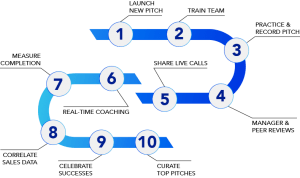 Product marketers should be active participants in driving message alignment. Not only will this ensure your salespeople are conversationally competent, but it will also help you understand how, where, and when they are learning and using the content you provide. Which, in turn, makes it easy for your team to build better content. When your salespeople start closing more deals, they’ll begin to truly appreciate the product marketing team and the fantastic content you deliver.
Product marketers should be active participants in driving message alignment. Not only will this ensure your salespeople are conversationally competent, but it will also help you understand how, where, and when they are learning and using the content you provide. Which, in turn, makes it easy for your team to build better content. When your salespeople start closing more deals, they’ll begin to truly appreciate the product marketing team and the fantastic content you deliver.
#5: Measure the Metrics That Matter Most
The fifth pillar of the Product Marketing Playbook for Sales Enablement is all about measuring the metrics that matter most. What you need to remember here is that it’s not all about your content. I’m not talking about measuring who watched your videos or who downloaded your eBooks. What you really need to measure are the metrics that matter most to revenue leaders:
- Seller ramp time
- Win rates
- Quota attainment
You need to be measuring the leading indicators so you can understand what is and isn’t helping to move the revenue needle. The reality is that most sellers are not hitting quota. According to CSO Insights, the quota attainment average is 60%. So, something is off. There are way too many sellers that aren’t hitting their numbers. Why? Well, one big problem is that most sales enablement professionals are looking at the wrong kind of data. They’re looking at completion data, “Did the salespeople do all the training?” They’re looking at consumption data, “Did they watch all the videos?” They’re looking at certifications data, “Did they get that certification?” And that data is important, but there’s more meaningful data that you should be looking at, including activity metrics, conversion metrics, and outcome metrics. Here’s what you should be looking at:
Activity metrics
– Calls made
– Emails sent
– Meetings held
– Opportunities created
Conversion metrics
– Leads to meetingsMeetings to opportunities
– Stage 1 to Stage 2
– Win rate
– Renewal rate
Outcome metrics
– Closed won bookings
– New logos
– Average cycle time
– Average deal size
Another way to think about it is by connecting the metrics back to the standard sales process we discussed earlier:
- Prospecting
- Calls
- Emails
- Meetings
- Diagnosing
- Discovery calls
- Meeting recaps
- Call recordings
- Prescribing
- Proposals
- Demonstrations
- Document sharing
- Gaining commitment
- eSignatures
Ask for this information before rolling out anything new. Make sure you’ll have access to these leading indicators so that you can determine whether or not your initiatives are actually making a difference.
Here’s a video replay of the Product Marketing Playbook for Sales Enablement you can watch.
Embrace Sales Enablement as a Strategic Product Marketer
For those of you that are newer to sales enablement, or those of you that want to up-level sales enablement, we do you have an amazing offer:
Sales Enablement Leadership Course
We personally curated this course, and I’m excited for you to take advantage of this. The course is free and available in SalesHood now. The course consists of six classes, each led by a sales enablement master:
- Class 1: Being strategic
- Class 2: Revenue Outcomes
- Class 3: Sales Plays
- Class 4: Messaging Alignment
- Class 5: Onboarding
- Class 6: Business Case
Each class takes 30 minutes on average. And, again, it’s totally free. Sign up here.
